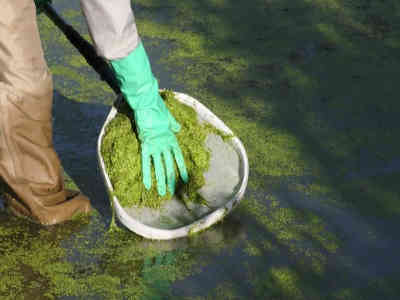By Tim Schley
With a $1.7 million grant from the National Science Foundation, Penn State researchers will investigate how duckweed could be grown on Pennsylvania farms to limit nutrient pollution into the Chesapeake Bay.
Duckweed, a tiny plant resembling a lily pad, grows rapidly in water with elevated levels of nitrogen and phosphorus, often the result of fertilizer and manure runoff. While many consider the plant a pest, farmers may find duckweed doubly beneficial, according to Rachel Brennan, associate professor of environmental engineering and lead investigator of the project.
“Not only can duckweed capture the nutrients before they cause problems like algal blooms and dead zones, but it can also ‘upcycle’ those nutrients into something that farmers can use again,” Brennan said. “It can be harvested multiple times per week and used as a feed supplement for farm animals. We have also demonstrated that it can be used as a soil amendment to support crop growth with much less runoff than conventional fertilizer. Duckweed has enormous potential for taking a waste product and giving it greater value.”
In a preliminary assessment, Brennan’s team calculated an estimated economic return for farmers if they repurposed some of their land from growing soybeans — often used for cattle feed — into a pond to grow duckweed. By mixing manure with water in the pond instead of applying it to an open field, farmers could not only reduce waste but also produce more protein.
“Soybeans contain an enormous amount of protein, but they do not grow very quickly,” Brennan said. “Duckweed’s protein content is high and so is its growth rate, so it has a higher yield. Given the same area, you can produce more protein if you switch to this little aquatic plant.”
In the four-year project, a multidisciplinary series of experiments will evaluate both the environmental and economic benefits of the team’s duckweed proposal. Co-investigators on the project include Lauren McPhillips, assistant professor of civil and environmental engineering and agricultural and biological engineering; Wayne Curtis, professor of chemical engineering; Alexander Hristov, distinguished professor of dairy nutrition; and Christine Costello, assistant professor of agricultural and biological engineering.

Considered a pest by many pond owners, duckweed is a "hyper accumulator" that helps to filter nutrient pollution. However, the plant must be removed from the water prior to decomposition to reap the benefits, according to Rachel Brennan, associate professor of environmental engineering.
The team will first work with Matt Royer, director of the Penn State Agriculture and Environment Center, and Penn State Extension dairy advisers to survey local dairy farmers for their initial impressions of the proposal. Dairy operations make up a significant portion of the farms in Pennsylvania, which covers 35% of the Chesapeake Bay watershed.
“For this to work, it needs to be economically advantageous for farmers,” Brennan said. “They should not have to buy as much chemical fertilizer or feed because they can take their own waste nutrients, convert them to duckweed and then use them again.”
Some of the experiments in the project focus on duckweed’s performance as a feed supplement, including how well cows digest the plant and its impact on milk production, as well as ways to improve both.
Others will investigate duckweed’s effects as a fertilizer. According to McPhillips, there are indications it might not only reduce the amount of nutrients in runoff but could also reduce the emission of nitrous oxide, the third most abundant greenhouse gas.
“A main goal of this project is to leverage duckweed to help reduce harmful nutrient losses of any sort,” she said. “A less-considered pathway is the loss of nitrous oxide, which can be produced by microbes in the environment. Generating soil amendments and feed supplements on site also reduces the energy consumption and greenhouse gas emissions that would have otherwise been required to produce and transport them to the farm.”
The team also plans to examine the proposal from a holistic perspective, brainstorming ways a duckweed-based “circular bioeconomy” could sustainably scale beyond local farms.
“Collecting biomass from fields to make ethanol in central processing plants is a well-established practice, and maybe a similar approach could be used for collecting manure from farms to produce duckweed,” Brennan said. “It could be vertically farmed in large warehouses because it only needs about an inch of water to grow. It would be a big change, but any major transformation to agriculture is going to seem radical at first.”
Source : psu.edu